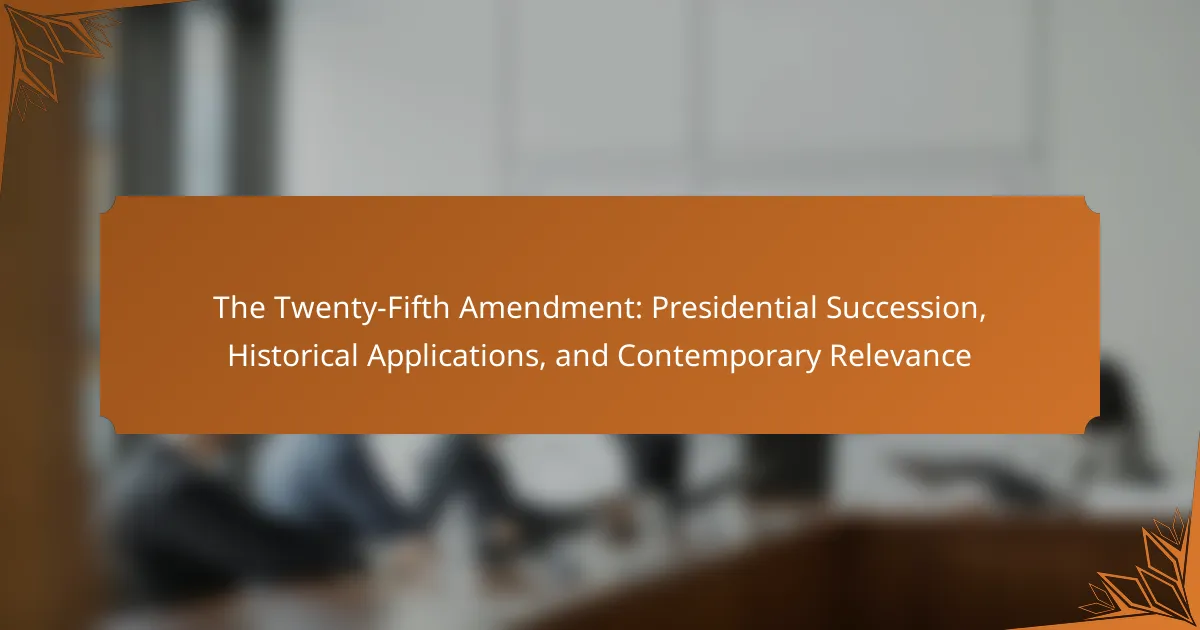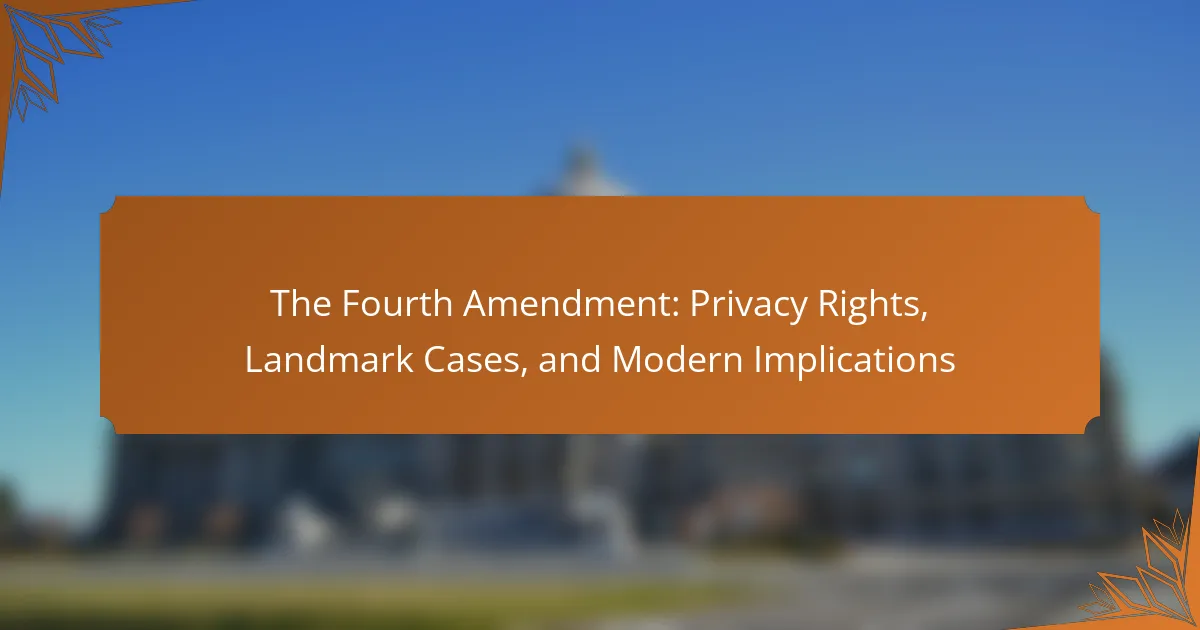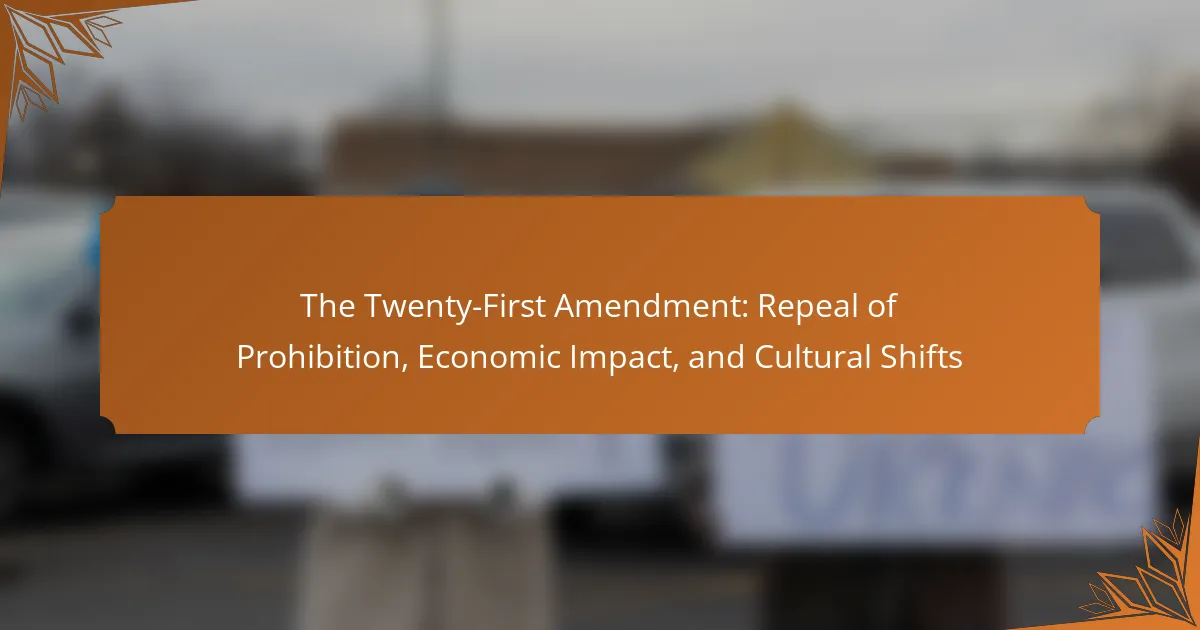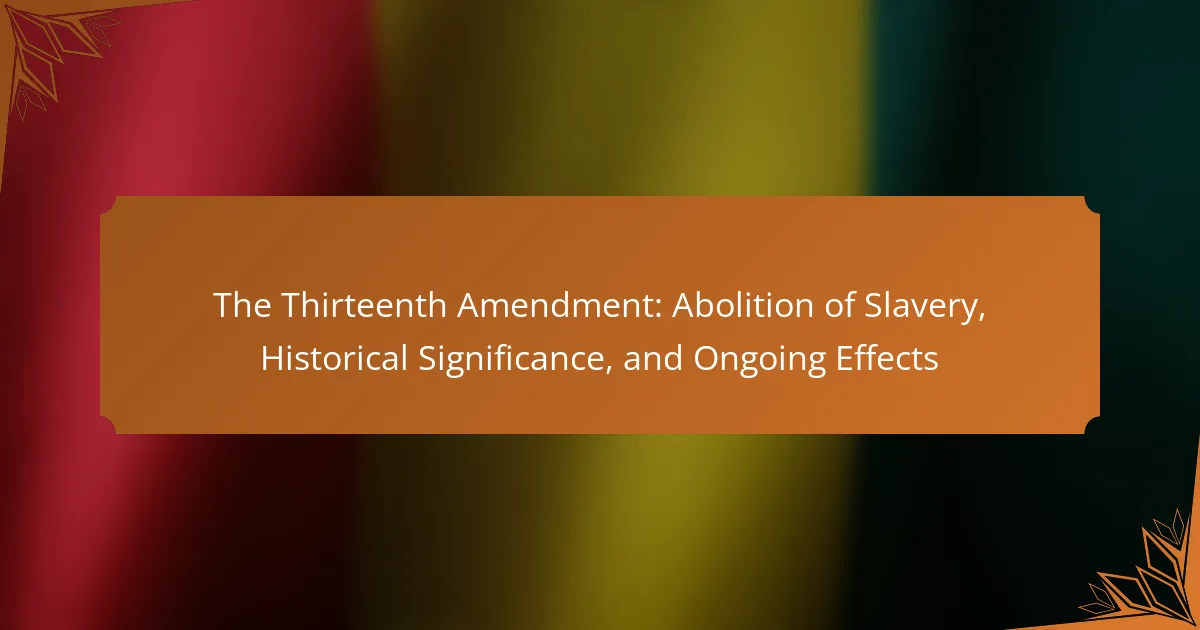The Twenty-Fifth Amendment is a provision in the United States Constitution that outlines presidential succession and procedures for addressing presidential disability. Ratified in 1967, it clarifies the process for filling a vacancy in the Vice Presidency and allows for the temporary transfer of presidential power during incapacitation. Historically, the amendment has been invoked during significant events, including the resignations of Vice President Spiro Agnew and President Richard Nixon, as well as President Ronald Reagan’s surgery in 1985. Its contemporary relevance continues to grow as it provides a framework for ensuring government continuity and stability in times of crisis, particularly in discussions surrounding presidential health and fitness for office.

What is the Twenty-Fifth Amendment?
The Twenty-Fifth Amendment is a provision in the United States Constitution. It addresses presidential succession and disability. Ratified in 1967, it clarifies the process for filling a vacancy in the office of the Vice President. The amendment also outlines procedures for the President to temporarily transfer power. This includes situations where the President is incapacitated. The amendment has been invoked several times in U.S. history. For example, it was used when President Reagan underwent surgery in 1985. The Twenty-Fifth Amendment ensures continuity of government during crises.
How does the Twenty-Fifth Amendment define presidential succession?
The Twenty-Fifth Amendment defines presidential succession by establishing procedures for filling a vacancy in the presidency. It states that if the president is removed from office, dies, or resigns, the vice president becomes president. The amendment also outlines the process for selecting a new vice president. This process requires the president to nominate a successor, who must then be confirmed by a majority vote in both houses of Congress. The amendment was ratified in 1967 to clarify succession issues that arose during the assassination of President John F. Kennedy.
What are the key provisions of the Twenty-Fifth Amendment?
The key provisions of the Twenty-Fifth Amendment address presidential succession and disability. The amendment consists of four sections. Section 1 establishes that if the presidency becomes vacant, the Vice President assumes the role of President. Section 2 allows the President to nominate a new Vice President, subject to congressional approval. Section 3 provides a procedure for the President to voluntarily transfer power to the Vice President during temporary incapacitation. Section 4 outlines the process for the Vice President and a majority of the Cabinet to declare the President unable to perform duties, allowing the Vice President to assume power. These provisions were ratified in 1967 to clarify presidential succession and address issues of presidential disability.
How does the amendment address presidential disability?
The Twenty-Fifth Amendment addresses presidential disability by establishing procedures for determining when a president is unable to fulfill their duties. It allows the vice president and a majority of the cabinet to declare the president incapacitated. This declaration must be communicated to Congress. If the president contests this declaration, Congress must decide the issue within 21 days. The amendment ensures a clear process for maintaining governmental continuity during periods of presidential incapacity. This was notably invoked when President Ronald Reagan underwent surgery in 1985, temporarily transferring power to Vice President George H.W. Bush.
Why was the Twenty-Fifth Amendment created?
The Twenty-Fifth Amendment was created to address presidential succession and disability. It was adopted in 1967 in response to concerns about the continuity of government. The amendment clarifies the procedures for filling a vacancy in the office of the Vice President. It also establishes protocols for determining presidential incapacity. These provisions were necessary after the assassination of President John F. Kennedy. The amendment aimed to ensure a clear line of authority during emergencies. Its creation reflects the need for stability in the executive branch. The Twenty-Fifth Amendment has been invoked multiple times since its ratification.
What historical events prompted its adoption?
The Twenty-Fifth Amendment was prompted by several historical events. The assassination of President John F. Kennedy in 1963 highlighted the need for clear presidential succession. This tragedy raised concerns about the continuity of government. Additionally, the health issues of President Dwight D. Eisenhower during his presidency created uncertainty regarding presidential power. Eisenhower suffered a heart attack in 1955, leading to questions about the transfer of authority. The amendment was also influenced by concerns over the mental fitness of leaders. These events collectively underscored the importance of a structured process for presidential succession and disability.
How does it reflect the concerns of its time?
The Twenty-Fifth Amendment reflects the concerns of its time by addressing the need for a clear line of presidential succession. It was ratified in 1967, during a period marked by political instability and assassinations. The assassination of President John F. Kennedy in 1963 heightened fears regarding presidential continuity. The amendment ensures that the vice president can assume the presidency if the president is incapacitated. This was a direct response to the uncertainty surrounding presidential power during crises. Historical context shows that previous practices were inadequate, creating potential governance issues. The amendment also includes provisions for filling a vice presidential vacancy, reflecting concerns about stable leadership. Overall, it encapsulates the era’s demand for a structured approach to succession and governance.
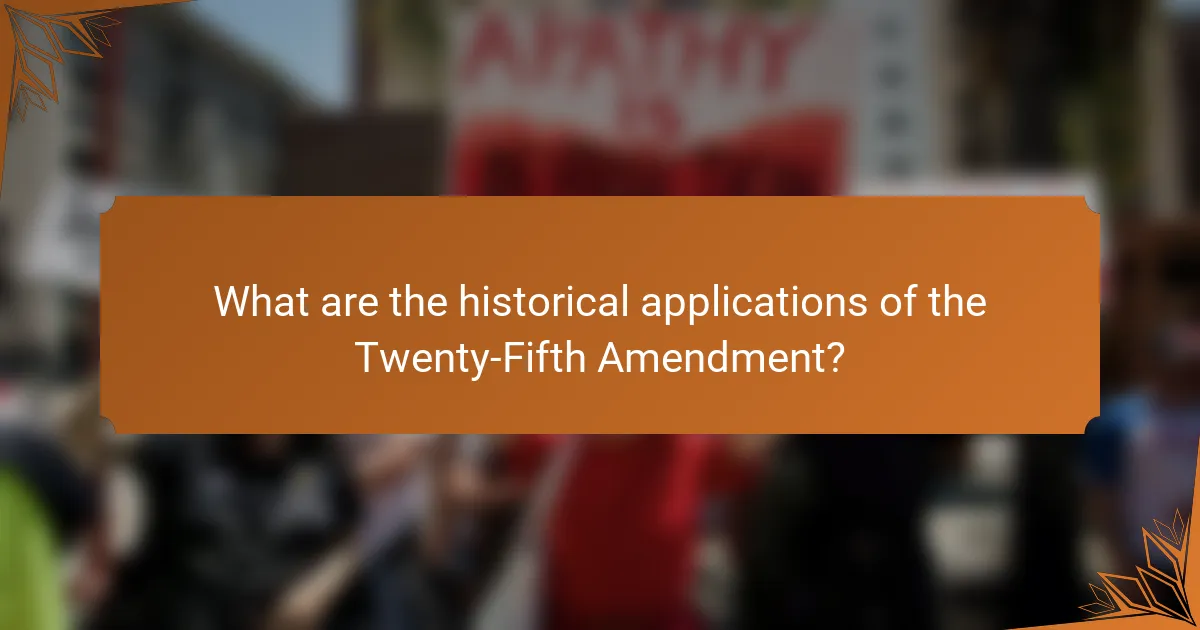
What are the historical applications of the Twenty-Fifth Amendment?
The Twenty-Fifth Amendment has been applied historically to address presidential succession and incapacity. It was first invoked in 1973 when Vice President Spiro Agnew resigned. Gerald Ford was nominated and confirmed as his replacement. The amendment was used again in 1974 when President Richard Nixon resigned. Ford then assumed the presidency.
In 1985, the amendment was invoked temporarily when President Ronald Reagan underwent surgery. Vice President George H.W. Bush assumed presidential powers during this time. The amendment provides a clear process for filling a vacancy in the vice presidency and for addressing presidential incapacity.
These applications demonstrate the amendment’s role in ensuring continuity of government. The historical instances highlight its importance in maintaining stability during transitions of power.
How has the amendment been invoked in U.S. history?
The Twenty-Fifth Amendment has been invoked in U.S. history primarily to address presidential disability and succession. It was first invoked in 1973 when Gerald Ford was nominated as vice president after Spiro Agnew’s resignation. The amendment was applied again in 1985 when President Ronald Reagan underwent surgery and temporarily transferred power to Vice President George H.W. Bush. It was also invoked in 2002 and 2007 when President George W. Bush underwent anesthesia for medical procedures, leading to temporary power transfer. In 2021, discussions arose regarding its potential use amid concerns about President Joe Biden’s age and health. These instances demonstrate the amendment’s role in ensuring continuity of government during times of presidential incapacitation.
What notable instances of presidential succession have occurred?
Notable instances of presidential succession include the transitions following the assassinations of Presidents Abraham Lincoln in 1865 and John F. Kennedy in 1963. After Lincoln’s assassination, Vice President Andrew Johnson assumed the presidency. Johnson faced significant challenges during Reconstruction. Following Kennedy’s assassination, Lyndon B. Johnson was sworn in on Air Force One. This event highlighted the urgency and gravity of presidential succession. Another significant instance is the resignation of President Richard Nixon in 1974, leading to Gerald Ford’s ascension. Ford is the only president to have assumed office without being elected. These instances underscore the importance of the presidential succession process outlined in the Twenty-Fifth Amendment.
How was the amendment applied during presidential disabilities?
The Twenty-Fifth Amendment was applied during presidential disabilities to ensure continuity of government. It allows the Vice President to assume the presidency if the President is unable to fulfill their duties. This provision was invoked during President Ronald Reagan’s surgery in 1985. Vice President George H.W. Bush temporarily assumed presidential powers during Reagan’s anesthesia recovery. The amendment also outlines procedures for the President to voluntarily transfer power. Additionally, it provides a mechanism for the Cabinet and Vice President to declare a President incapacitated. This was notably discussed during President Woodrow Wilson’s illness in 1919. The amendment has been crucial in maintaining government function during times of presidential incapacity.
What impact did the amendment have on political stability?
The Twenty-Fifth Amendment significantly enhanced political stability in the United States. It established clear procedures for presidential succession and disability. This clarity reduces uncertainty during transitions of power. For instance, following President Kennedy’s assassination in 1963, the amendment was crucial in ensuring a smooth transfer to Lyndon B. Johnson. This prevented potential power vacuums and maintained governmental continuity. The amendment also allows for the appointment of a new vice president if the position becomes vacant. This provision ensures that the executive branch remains fully functional. Overall, the amendment has strengthened the resilience of the political system during crises.
How did it change the perception of presidential succession?
The Twenty-Fifth Amendment changed the perception of presidential succession by formalizing the process for filling a vacancy in the presidency and vice presidency. It clarified the roles of the vice president and Congress in cases of presidential disability or vacancy. Before its ratification in 1967, there was ambiguity regarding succession procedures. The amendment established that the vice president would assume the presidency if the president is unable to fulfill their duties. Additionally, it allowed for the appointment of a new vice president when that office becomes vacant. This framework enhanced the stability of the executive branch and reassured the public about continuity in leadership. The amendment’s implementation during the Nixon administration, particularly after his resignation, underscored its significance in maintaining governmental integrity.
What lessons were learned from its historical applications?
The historical applications of the Twenty-Fifth Amendment reveal key lessons about presidential succession. First, clarity in succession procedures is crucial for national stability. The amendment was invoked during the Watergate scandal, highlighting the need for a clear process when a president is unable to serve. Second, the importance of communication between the president and vice president is evident. This was demonstrated when President Reagan underwent surgery in 1985, requiring effective transfer of power. Third, the amendment underscores the necessity for timely action in crises. The swift invocation of the amendment during the 1973 resignation of Vice President Spiro Agnew illustrates this point. Lastly, the amendment teaches that legislative frameworks must adapt to evolving political contexts. Its application during various administrations shows the necessity for flexibility in governance. These lessons emphasize the importance of a robust succession plan in maintaining government functionality.
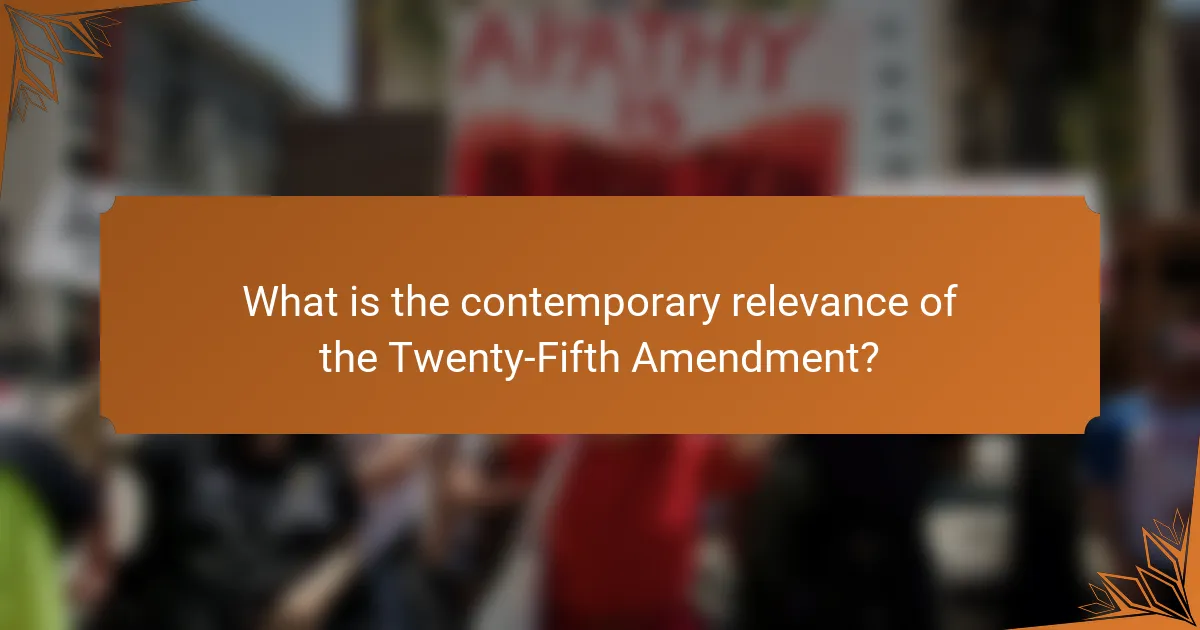
What is the contemporary relevance of the Twenty-Fifth Amendment?
The contemporary relevance of the Twenty-Fifth Amendment lies in its provisions for presidential succession and addressing presidential disability. This amendment allows for a clear process when a president is unable to perform their duties. It has been invoked in recent history during instances of health concerns and transitions of power. The amendment ensures continuity of government and stability during crises. For example, it was discussed during President Ronald Reagan’s surgery in 1985. Additionally, it has been referenced in discussions about the mental fitness of presidents. The amendment’s mechanisms provide a framework for addressing unforeseen circumstances in leadership. Its importance continues to grow as political environments evolve and health issues become more scrutinized.
How does the amendment apply to today’s political landscape?
The Twenty-Fifth Amendment applies to today’s political landscape by providing a clear framework for presidential succession and disability. This amendment ensures continuity of government during crises, such as health emergencies or political instability. Recent events, including the COVID-19 pandemic, have highlighted its importance. The amendment allows for the vice president to assume presidential powers if the president is incapacitated. This provision was notably referenced during discussions about President Biden’s health. Furthermore, it fosters accountability and transparency in leadership transitions. The amendment’s relevance is underscored by ongoing debates about presidential fitness and succession planning. Its application helps to maintain stability and public confidence in government functions.
What current events highlight the importance of the Twenty-Fifth Amendment?
Current events highlighting the importance of the Twenty-Fifth Amendment include discussions surrounding presidential health and capability. Recent instances involve public concerns about the mental and physical fitness of high-ranking officials. For example, health issues affecting President Biden have sparked debates about succession protocols. Additionally, the January 6 Capitol riot raised questions about the stability of leadership during crises. These events underscore the necessity of having clear procedures for presidential succession and disability. The Twenty-Fifth Amendment provides a framework for addressing such situations effectively.
How do political leaders view the amendment in modern times?
Political leaders view the Twenty-Fifth Amendment as a crucial mechanism for ensuring presidential stability and continuity. Many leaders emphasize its importance in addressing presidential incapacity. For instance, during health crises, leaders have cited the amendment’s provisions to ensure a clear line of succession. Recent discussions around the amendment highlight its relevance in modern governance. Political leaders recognize that it provides a framework for transferring power effectively. The amendment is often referenced in debates about mental health and fitness for office. Leaders advocate for its application to maintain public confidence in government stability. Overall, the amendment is seen as vital for contemporary political leadership and governance.
What are the potential future implications of the Twenty-Fifth Amendment?
The potential future implications of the Twenty-Fifth Amendment include increased clarity in presidential succession and the handling of presidential incapacity. This amendment allows for a clear process to transfer power if a president is unable to fulfill their duties. Future applications may involve more frequent use of Section 4, which permits the Cabinet and the Vice President to declare a president incapacitated. Recent political events have highlighted the need for clear protocols during crises. The amendment could lead to legal challenges regarding its interpretation and application. Additionally, it may prompt discussions about mental health and leadership fitness. The ongoing evolution of political norms could shape its use in unforeseen ways.
How might the amendment evolve with changing political dynamics?
The Twenty-Fifth Amendment may evolve as political dynamics shift. Changes in party control can influence its application. For example, a new administration may interpret the amendment differently. Political crises could prompt lawmakers to propose amendments for clarity. Historical precedents show that amendments often reflect societal needs. The increasing polarization in politics may lead to more frequent discussions about succession. Recent events, such as presidential health concerns, highlight its relevance. Thus, the amendment’s interpretation is likely to adapt to contemporary political challenges.
What challenges could arise regarding its implementation?
Challenges regarding the implementation of the Twenty-Fifth Amendment include political resistance and ambiguity in its provisions. Political resistance can stem from partisan disagreements on the necessity of invoking the amendment. Ambiguity exists in defining “inability” and the processes for declaring a president unfit. Historical applications demonstrate inconsistencies in its use, which can lead to confusion and conflict. For instance, the amendment has rarely been invoked, creating uncertainty about its practical application. Moreover, the lack of clear guidelines may result in legal disputes over its interpretation. These challenges highlight the complexities surrounding presidential succession and the need for clarity in the amendment’s application.
What best practices should be considered regarding the Twenty-Fifth Amendment?
Best practices for the Twenty-Fifth Amendment include clear communication among government officials. This ensures swift action during presidential incapacitation. Establishing a protocol for invoking the amendment is crucial. The process should involve the Vice President and a majority of the Cabinet. Documentation of the President’s condition is essential for transparency. Regular training for officials on the amendment’s procedures can enhance readiness. Historical instances, such as President Reagan’s surgery in 1985, illustrate the importance of these practices. Effective implementation can maintain governmental stability during crises.
The Twenty-Fifth Amendment is a provision in the United States Constitution that addresses presidential succession and disability, ratified in 1967. It establishes procedures for filling a vacancy in the presidency and vice presidency, as well as protocols for determining presidential incapacity. The amendment has historical significance, having been invoked during key events such as the resignations of Presidents Nixon and Agnew, and President Reagan’s surgery. Its contemporary relevance is underscored by ongoing discussions about presidential health and stability, highlighting the importance of clear succession protocols in modern governance. The article explores the amendment’s provisions, historical applications, and implications for today’s political landscape.
